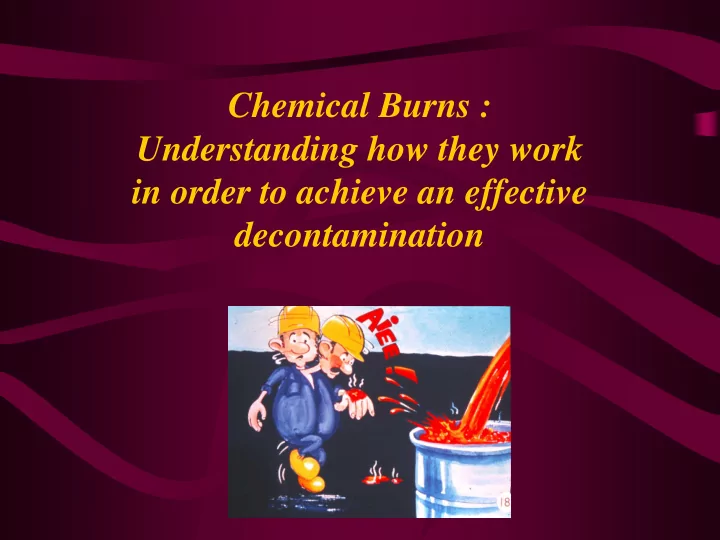

Chemical Burns : Understanding how they work in order to achieve an effective decontamination
The seriousness of a chemical burn – Depends on: ➢ the kind of chemical product and its concentration ➢ the length of the contact ➢ the size of the affected surface area ➢ the physical parameters (temperature, pressure)
Which chemicals produce chemical burns? • Corrosives and irritants : – acids, bases, oxidizers, reducing agents, solvents – or in other words, about 25 000 chemicals • It is important to note: a corrosive or an irritant can be toxic as well as noxious !
What is Diphoterine? • A aqueous solution containing the base properties of water = the effect of pulling the chemical aggressor away from the surface of the tissues + An amphoteric solution = acts on acids as well as bases, and rapidly restores the eye and/or skin’s physiological pH + A hypertonic solution = stops the penetration of corrosive chemicals into the tissues creating a flux from the inside to the outside of the tissues A medical device CE 0459, class IIa
Diphoterine • Innocuousness and properties ➢ non irritating to the eyes or skin ➢ non toxic (DL 50 acute oral, dermal > 2000 mg/kg) ➢ non irritating rinsing residues (for acids and bases) ➢ non sensitizing, non mutagenic (Ames test) ➢ no side effects have been reported in workplace use ➢ immediate decrease in pain
Skin study in rats (concentrated HCl burn) Diphoterine versus saline solution • Significant statistical results in favor of Diphoterine ➢ Decrease of inflammation ➢ (IL-6 à 48h, p < 0.01; à 7 days, p < 0.05) ➢ Decrease in pain ➢ (substance P within 48h, p < 0.05; -endorphin at 7 days, p<0.05) ➢ Decrease in the size of the lesions ➢ (no rinsing : 12mm; saline solution : 6 mm; Diphoterine 4 mm) ➢ Improvement of the scarring
Ocular study in rabbits (concentrated ammonia burn) Diphoterine versus saline solution ➢ Decrease in the inflammation, absence of oedema ➢ Decrease in pH
Ocular study in rabbits (concentrated ammonia burn) Stromal oedema No rinsing Saline solution No stromal oedema Diphoterine
Clinical results of 42 cases of chemical splashes Martinswerk, Allemagne, 1991-1993 Rinsing Diphoterine acetic acid water Sick leave 0.18j ±0.4 2.91j ± 4.3 8j ± 8.12 No care 100% ±15 0% ±15 0% ±15 Basic care 25% ± 15 % ±15 80% ±15 Medical care 0% ± 15 20% ± 15 75% ± 15 Chemical in question : lye (40-600 g/l) Protocol : On site rinsing Results : Variability of the effectiveness of water rinsing , significant improvement with Diphoterine rinsing
Series of 175 cases of chemical splashes RHONE-POULENC, France, 1987-1996
Series of 24 cases of splashes Manxman, Allergen, 1994-98 Splashes Eye Skin Acids* 11 8 Bases** 4 1 * acids : sulfuric, nitric, phosphoric, sulfamic (5-100%) ** bases : calciumoxide, lye 30-45%, basic solution 30% Protocol : Diphoterine on site + infirmary Results : No after effects, no secondary care, no sick leave
Study of 375 cases at ATOFINA, France, 2000 Rinsing water Diphoterine Sick leave 7(3.4%) 0(0%) (p < 0.05) Without sick leave 198 170 Without follow-up* 68(52%) 88(33%) (p<0.05) With follow-up 137 82 *The criterion without follow-up corresponds to no care Chemical : Acrylates, sulfuric acid (98%), Oleum, lye (22%), Diethylaminoacrylate (ADAME) Results : Significant difference in sick leave, as well as in the necessity of secondary care
Clinical study in Martinique Comparison saline solution / Diphoterine Delayed ocular rinsing - Teams : fire-fighters, Emergency Medical Assistance Service (SAMU), Accident and Emergency, Ophthalmology - Number of patients : 66 during 4 years (before/after study) 48 eyes (46%) saline solution / 56(54%) Diphoterine - Protocol : rinsing with saline solution or Diphoterine then the same treatment according to the stage of the burn - Chemicals : bases (48% with Alkali-ammonia 15.3%) - Nature of the splash : attack - victim : male (2 patients out of 3)
Clinical study in Martinique Comparison saline solution / Diphoterine Delayed ocular rinsing Length of time (days) Saline Diphoterine p reepithelialisation solution 11.1 1.4 1.9 1 stage 1 10-7 10 9.2 5.6 4.9 stage 2 0.02 45.2 23 20 14.1 stage 3 0.21 NS Results : significant difference for stages 1 and 2, tendency for stage 3, no stage 4 in the group Diphoterine
Conclusion Rinsing with Diphoterine can be carried out following two protocols : - either as first aid in the workplace, with the objective of preventing or minimising the appearance of chemical burns. - or in the case of hospital treatment, to stop the progression of chemical burns, which allows a rapid return to a physiological state, and permits a secondary treatment adapted to the seriousness of the burn.
Recommend
More recommend